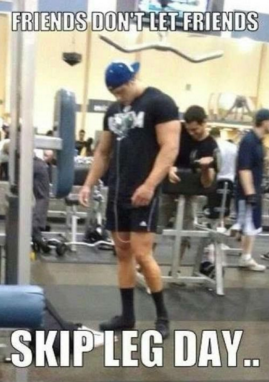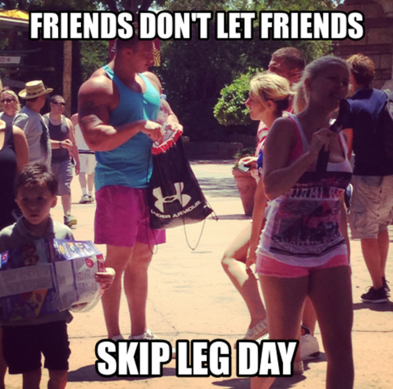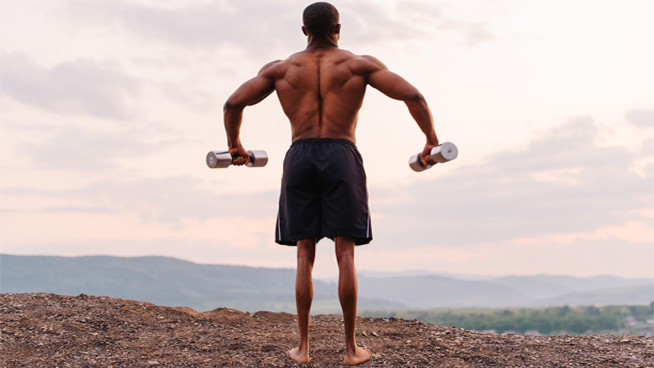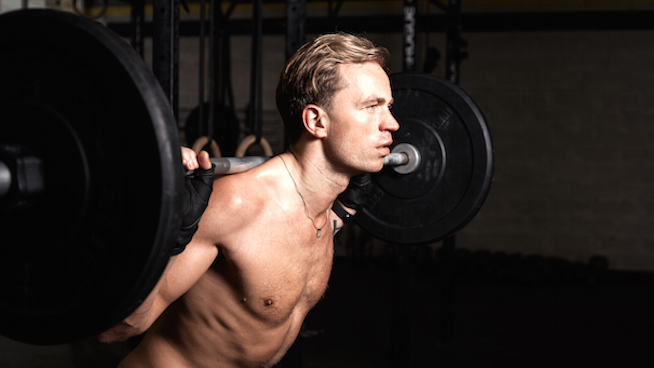6 Reasons Why You Should Never Skip Leg Day Again
“Friends don’t let friends skip a leg day.” Google this phrase and you will see a number of photos showing guys who have jacked upper bodies and twig legs.
Here’s one example:

And here’s another:

The phrase is good advice because it’s all too common for people to skip a leg day.
Leg workouts are hard, no doubt. Squats, Deadlifts and other leg exercises are physically demanding, and the soreness afterward can be beyond unpleasant. Couple these facts with the general preference for upper-body lifts, and you have a perfect list of excuses for someone to justify skipping leg day.
But it’s one of the worst things you can do in your workouts. So in this article, I’ll be your friend and attempt to convince you to never skip leg day.
Reason 1: You Will Look Ridiculous

We can all agree the guys in the photos above look silly. They clearly spend most of their time in the gym hammering their chest, arms and shoulders. Maybe they get some Leg Curls and Extensions in from time to time. But even that is a stretch.
The result is embarrassingly small glutes and quads. You might be able to get away with a skipping a leg workout here and there (not ideal for all the reasons below), but becoming a serial leg-workout skipper will result in your exposure on the Internet, turning you into a meme like the pour souls above.
You’ve been warned.
Reason 2: You Will Suck at Sports

Except for pool sports, sports are played from the ground up. Obvious skill examples are sprinting and jumping.
However, even upper-body-centric skills like throwing a ball, swinging a bat and taking a slapshot follow this rule. Your lower-body muscles drive into the ground to create power, which travels up through your core and into whatever upper-body movement you are performing.
“In most sports, the power and everything you have comes from ground force production. Everything starts at the ground, moving from your ankles, knees and hips to your upper body,” states Ben Boudro, owner of Xceleration Sports (Auburn Hills, Michigan). “Your legs are your foundation. The stronger your foundation, the stronger and faster you will be in your skills.”
Try performing one of these skills without using your lower body and notice how your performance suffers.
The key leg muscles are the glutes, hamstrings and quads. Others muscles are involved, but we will focus on those three for the sake of simplicity. If you don’t train these muscles, it’s almost impossible to improve your sports skills and reach your potential no matter how talented you are.
Put simply, you will be a slow and weak athlete because of poor training choices.
RELATED: How Your Deadlift Max Will Make You Faster
Reason 3: You Will Neglect 2 of the Big 3 Lifts

The Big 3 lifts are the Bench Press, Squat and Deadlift. They work the major muscle groups of the body. (We could argue that an upper-body pulling exercise should be added, but that’s for another article.)
You should be doing these lifts if your goal is to get stronger, build muscle and even lose weight (more on this below). That’s why a vast majority of training programs feature these exercises and their variations. There’s no doubting their effectiveness.
Yet, too often the benches in the gym are 100 percent occupied, while the squat racks and areas where it’s possible to deadlift are completely vacant. This is very telling about most people’s priorities.
RELATED: Fix the 3 Key Exercises You’re Doing Wrong
Reason 4: It’s Harder to Build Muscle

The muscles in your hips and legs are the largest in your body. Boudro explains that training these muscles causes a massive release of growth hormone and testosterone, key elements for building muscle.
Assuming you do it correctly, training your lower-body muscles causes them to grow. But it also creates an anabolic environment in your body that can improve the muscle-building effects of your upper-body lifts.
Want to get a thicker torso? Do Deadlifts. Although it’s considered a lower-body lift, holding hundreds of pounds is one of the best ways to build your upper back, traps and grip.
The biggest and strongest people train their legs regularly. It’s non-negotiable.
WATCH: The Benefits of the Trap Bar Deadlift
Reason 5: It Makes It Harder to Burn Fat

Once again, neglecting the largest muscles in your body poses a problem.
Let’s say you want to lose weight. You’re probably looking for workouts that burn the most calories. The solution: do more lower-body exercises. The largest muscles in your body require the most energy to function, so working your legs will likely increase the amount of calories you burn in a typical workout.
Boudro adds, “One of the best exercises is the Squat. It’s going to work the entire body, and it hits the largest muscles in the body so it burns a lot of calories and you’re going to continue to burn more calories after your workout is finished.”
You also need to consider that adding muscle mass increases your resting metabolic rate—i.e., the number of calories your body burns at rest. So it only makes sense to focus a major part of your workouts on training the largest muscles in your body—the key to effective long-term fat loss.
Reason 6: You Will Be More Susceptible to Injury
If you’re an athlete, you probably understand the concept that a stronger lower body is more resistant to injury.
But sometimes athletes fall into a trap where they think their sport trains their legs sufficiently. Problem is, most athletic movements overemphasize the quads, creating what’s called quad dominance.
One common result of quad dominance? ACL injuries, especially in female athletes.
“If your hamstring isn’t developed and you’re not doing hip work, you’re so overdeveloped on the front part of your body and underdeveloped on the backside of your body, it will eventually lead to injury,” says Boudro.
That’s why it’s absolutely essential to regularly do leg work, and, more specifically, to strengthen your glutes and hamstrings.
RELATED: Prevent ACL Injuries With This Hamstring-Focused Workout
RECOMMENDED FOR YOU
6 Reasons Why You Should Never Skip Leg Day Again
“Friends don’t let friends skip a leg day.” Google this phrase and you will see a number of photos showing guys who have jacked upper bodies and twig legs.
Here’s one example:

And here’s another:

The phrase is good advice because it’s all too common for people to skip a leg day.
Leg workouts are hard, no doubt. Squats, Deadlifts and other leg exercises are physically demanding, and the soreness afterward can be beyond unpleasant. Couple these facts with the general preference for upper-body lifts, and you have a perfect list of excuses for someone to justify skipping leg day.
But it’s one of the worst things you can do in your workouts. So in this article, I’ll be your friend and attempt to convince you to never skip leg day.
Reason 1: You Will Look Ridiculous

We can all agree the guys in the photos above look silly. They clearly spend most of their time in the gym hammering their chest, arms and shoulders. Maybe they get some Leg Curls and Extensions in from time to time. But even that is a stretch.
The result is embarrassingly small glutes and quads. You might be able to get away with a skipping a leg workout here and there (not ideal for all the reasons below), but becoming a serial leg-workout skipper will result in your exposure on the Internet, turning you into a meme like the pour souls above.
You’ve been warned.
Reason 2: You Will Suck at Sports

Except for pool sports, sports are played from the ground up. Obvious skill examples are sprinting and jumping.
However, even upper-body-centric skills like throwing a ball, swinging a bat and taking a slapshot follow this rule. Your lower-body muscles drive into the ground to create power, which travels up through your core and into whatever upper-body movement you are performing.
“In most sports, the power and everything you have comes from ground force production. Everything starts at the ground, moving from your ankles, knees and hips to your upper body,” states Ben Boudro, owner of Xceleration Sports (Auburn Hills, Michigan). “Your legs are your foundation. The stronger your foundation, the stronger and faster you will be in your skills.”
Try performing one of these skills without using your lower body and notice how your performance suffers.
The key leg muscles are the glutes, hamstrings and quads. Others muscles are involved, but we will focus on those three for the sake of simplicity. If you don’t train these muscles, it’s almost impossible to improve your sports skills and reach your potential no matter how talented you are.
Put simply, you will be a slow and weak athlete because of poor training choices.
RELATED: How Your Deadlift Max Will Make You Faster
Reason 3: You Will Neglect 2 of the Big 3 Lifts

The Big 3 lifts are the Bench Press, Squat and Deadlift. They work the major muscle groups of the body. (We could argue that an upper-body pulling exercise should be added, but that’s for another article.)
You should be doing these lifts if your goal is to get stronger, build muscle and even lose weight (more on this below). That’s why a vast majority of training programs feature these exercises and their variations. There’s no doubting their effectiveness.
Yet, too often the benches in the gym are 100 percent occupied, while the squat racks and areas where it’s possible to deadlift are completely vacant. This is very telling about most people’s priorities.
RELATED: Fix the 3 Key Exercises You’re Doing Wrong
Reason 4: It’s Harder to Build Muscle

The muscles in your hips and legs are the largest in your body. Boudro explains that training these muscles causes a massive release of growth hormone and testosterone, key elements for building muscle.
Assuming you do it correctly, training your lower-body muscles causes them to grow. But it also creates an anabolic environment in your body that can improve the muscle-building effects of your upper-body lifts.
Want to get a thicker torso? Do Deadlifts. Although it’s considered a lower-body lift, holding hundreds of pounds is one of the best ways to build your upper back, traps and grip.
The biggest and strongest people train their legs regularly. It’s non-negotiable.
WATCH: The Benefits of the Trap Bar Deadlift
Reason 5: It Makes It Harder to Burn Fat

Once again, neglecting the largest muscles in your body poses a problem.
Let’s say you want to lose weight. You’re probably looking for workouts that burn the most calories. The solution: do more lower-body exercises. The largest muscles in your body require the most energy to function, so working your legs will likely increase the amount of calories you burn in a typical workout.
Boudro adds, “One of the best exercises is the Squat. It’s going to work the entire body, and it hits the largest muscles in the body so it burns a lot of calories and you’re going to continue to burn more calories after your workout is finished.”
You also need to consider that adding muscle mass increases your resting metabolic rate—i.e., the number of calories your body burns at rest. So it only makes sense to focus a major part of your workouts on training the largest muscles in your body—the key to effective long-term fat loss.
Reason 6: You Will Be More Susceptible to Injury
If you’re an athlete, you probably understand the concept that a stronger lower body is more resistant to injury.
But sometimes athletes fall into a trap where they think their sport trains their legs sufficiently. Problem is, most athletic movements overemphasize the quads, creating what’s called quad dominance.
One common result of quad dominance? ACL injuries, especially in female athletes.
“If your hamstring isn’t developed and you’re not doing hip work, you’re so overdeveloped on the front part of your body and underdeveloped on the backside of your body, it will eventually lead to injury,” says Boudro.
That’s why it’s absolutely essential to regularly do leg work, and, more specifically, to strengthen your glutes and hamstrings.
RELATED: Prevent ACL Injuries With This Hamstring-Focused Workout










